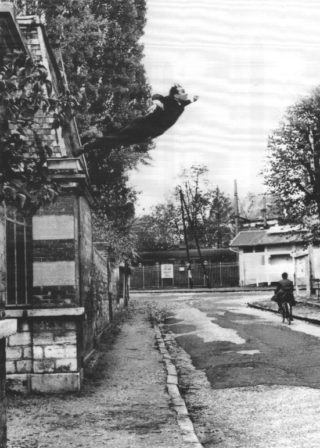
Leap into the Void (Wikipedia)
Today, I was reading an essay by Rebecca Solnit from her book, A Field Guide to Getting Lost, where she tells about the artist, Yves Klein, shown taking a leap in the photograph above.
It’s a startling image, taken in 1960. Solnit says that it was one document of a larger piece of work, “an artwork that was too remote, too ephemeral, too personal to be seen otherwise, an artwork that could not be exhibited and would otherwise be lost, so the photograph stands in for it.”
Klein did leap but there were trampolines underneath to catch his fall. Photographs were spliced together to remove the trampolines and create this image.
Klein was known for his exploration of the void, as well as his blue paintings. He painted globes and maps of the world entirely blue to take away any divisions between land, sky, and water, not to mention countries.
This reminded me of one of my favourite short essays of all time by Donella Meadows, Lines in the Mind, Not in the World (please read). The maps we create on paper are not the actual territory. The lines we create to separate ourselves from others are only of our own making. They don’t exist, except in our minds.
I then thought of John Lennon’s song, Imagine – no heaven or hell, no countries, no possessions. You may say that I’m a dreamer but I’m not the only one.
Yves Klein, Donella Meadows, and John Lennon were people who took leaps.
What if we were to imagine, just for one day, the world we inhabit as one big country with no lines?
Imagine a world where we were all responsible for doing our part in such a way that everyone and everything would thrive. Imagine everything having equal status, yet different abilities and purposes. It would be up to us to respond in each moment to what’s right in front of us, the best way that we can.
It’s been only a few days since the tragic events in Orlando, Florida that left 50 dead and many more injured, the largest mass shooting in American history. People everywhere are still reeling from the senselessness of it all. At times like these, the problems in our world seem so large. And, they are. Yet, there are things we can do, one small step (or leap) at a time. Here are a few ways to start. Pick one or develop your own.
2. Observe carefully an animal or plant that inhabits your space. Notice their size, colour, texture, shape, and behaviours. Imagine what their life is like, not from a human point of view but from their point of view. What do they contribute to the whole? Be grateful.
3. While driving or walking, be aware of the ground beneath your feet. Imagine what it’s like to be a road or a sidewalk or a lawn, not from a human point of view but from their point of view. Imagine being trod on all day and the different weather conditions they experience. Notice the wear and tear they endure. What are they contributing to the whole and to you? Be grateful.
Contemplative photography is about taking off the labels and judgments we put on things. It’s about seeing life as it is in the moment and responding accordingly. A good contemplative exercise for photographers is to see everything as a worthy subject. Notice what attracts your attention and don’t dismiss or reject anything. As a matter of fact, pay particular attention to those things that you would normally dismiss. Photograph those.
How does this practice open up your world? How does it change your experience and, consequently, how others experience you? Every small step, every leap, makes a difference, whether we can see it or not.
We can imagine our way into a world where there is more love by acting as if it’s already here.
** Books mentioned have Amazon affiliate links, meaning I make a few cents if you purchase through my link. I only recommend books that I’ve read.
I liked the short paragraph starting: “A good contemplative exercise for photographers is to see everything as a worthy subject.” Seeing everything as worthy is a good exercise in itself.
I enjoyed the article by Donella Meadows: “Lines in the mind, not in the world.” All excellent points to ponder, Kim.
Very meaningful & timely post, Kim. Thank you.
Such a wonderful post today. We do look at everything as “worthy.”